After a lot of research I found this solution. Just to make things clear I created an entire app for this question which serves the purpose of opening the camera clicking a photo and setting the image as the ImageBitmap of an ImageView. The code asked in this question starts at the second block i.e. the setView() method which is below the onCreate() method following which we have the onActivityResult() method
Here is a demo of the app.

Below I have Attached the MainActivity.java file
package com.cr7.opencamera;
import android.Manifest;
import android.app.Activity;
import android.content.ContentResolver;
import android.content.ContentValues;
import android.content.Intent;
import android.content.pm.PackageManager;
import android.graphics.Bitmap;
import android.net.Uri;
import android.os.Bundle;
import android.provider.MediaStore;
import android.util.Log;
import android.widget.Button;
import android.widget.ImageView;
import androidx.annotation.NonNull;
import androidx.annotation.Nullable;
import androidx.appcompat.app.AppCompatActivity;
import androidx.core.app.ActivityCompat;
import androidx.core.content.ContextCompat;
import java.io.IOException;
public class MainActivity extends AppCompatActivity {
private Button buttonCaptureImageFromCamera;
private Uri imageUri;
private ImageView imageViewCameraImage;
@Override
protected void onCreate(Bundle savedInstanceState) {
super.onCreate(savedInstanceState);
setContentView(R.layout.activity_main);
// Button that will open the camera
buttonCaptureImageFromCamera = findViewById(R.id.buttonCaptureImageFromCamera);
// ImageView that will store the image
imageViewCameraImage = findViewById(R.id.imageViewCameraImage);
askPermission();
}
This what you need for geting the Uri of the image here imageUri is a global variable so that it can be used in the onActivityResult() method
// Sets OnClickListener for the button if storage permission is given
private void setView() {
buttonCaptureImageFromCamera.setOnClickListener(v -> {
String fileName = "new-photo-name.jpg";
// Create parameters for Intent with filename
ContentValues values = new ContentValues();
values.put(MediaStore.Images.Media.TITLE, fileName);
values.put(MediaStore.Images.Media.DESCRIPTION, "Image capture by camera");
imageUri =
getContentResolver().insert(MediaStore.Images.Media.EXTERNAL_CONTENT_URI,
values);
Intent intent = new Intent(MediaStore.ACTION_IMAGE_CAPTURE);
intent.putExtra(MediaStore.EXTRA_OUTPUT, imageUri);
startActivityForResult(intent, 1231);
});
}
This is the onActivityResult method. Here I've used imageUri i.e. the global variable of type Uri which was initialized in the OnClickListener of the button in the setView() method above.
@Override
protected void onActivityResult(int requestCode, int resultCode, @Nullable Intent data) {
super.onActivityResult(requestCode, resultCode, data);
if (requestCode == 1231 && resultCode == Activity.RESULT_OK) {
try {
ContentResolver cr = getContentResolver();
try {
// Creating a Bitmap with the image Captured
Bitmap bitmap = MediaStore.Images.Media.getBitmap(cr, imageUri);
// Setting the bitmap as the image of the
imageViewCameraImage.setImageBitmap(bitmap);
} catch (IOException e) {
e.printStackTrace();
}
} catch (IllegalArgumentException e) {
if (e.getMessage() != null)
Log.e("Exception", e.getMessage());
else
Log.e("Exception", "Exception");
e.printStackTrace();
}
}
}
Remaining code...
// Asking user for storage permission
public void askPermission() {
// Checking if the permissions are not granted.
if (
ContextCompat.checkSelfPermission(
this,
android.Manifest.permission.WRITE_EXTERNAL_STORAGE
) != PackageManager.PERMISSION_GRANTED ||
ContextCompat.checkSelfPermission(
this,
android.Manifest.permission.READ_EXTERNAL_STORAGE
) != PackageManager.PERMISSION_GRANTED
) {
// If not granted requesting Read and Write storage
ActivityCompat.requestPermissions(this, /*You can ask for multiple request by adding
more permissions to the string*/new String[]{Manifest.permission.WRITE_EXTERNAL_STORAGE,
Manifest.permission.READ_EXTERNAL_STORAGE}, 60);
} else {
// If permissions are granted we proceed by setting an OnClickListener for the button
// which helps the user pick the image
setView();
}
}
// This method is called after the permissions have been asked i.e. the dialog that says
// allow or deny
@Override
public void onRequestPermissionsResult(int requestCode, @NonNull String[] permissions,
@NonNull int[] grantResults) {
super.onRequestPermissionsResult(requestCode, permissions, grantResults);
// Now by default we assume that the permission has not been granted
boolean allPermissionsGranted = false;
// Now we check if the permission was granted
if ( requestCode == 60 && grantResults.length > 0) {
// If all the permissions are granted allPermissionsGranted is set to true else false
allPermissionsGranted = grantResults[0] == PackageManager.PERMISSION_GRANTED
&&
grantResults[1] == PackageManager.PERMISSION_GRANTED;
}
// If permissions are granted we call the setView Method which prompts the user to pick
// an Image either by the clicking it now or picking from the gallery
if ( allPermissionsGranted ) {
setView();
}
}
}
These blocks of code are in sequence i.e. if you merge all these blocks you get the complete MainActivity.java class.
If you wan to Implement this app you need yo create a layout file with an ImageView with an id "imageViewCameraImage"and a button with an id "buttonCaptureImageFromCamera".
Hope this helps. I know this is long and I'm making it longer by writing this.
Regards,
Joel
